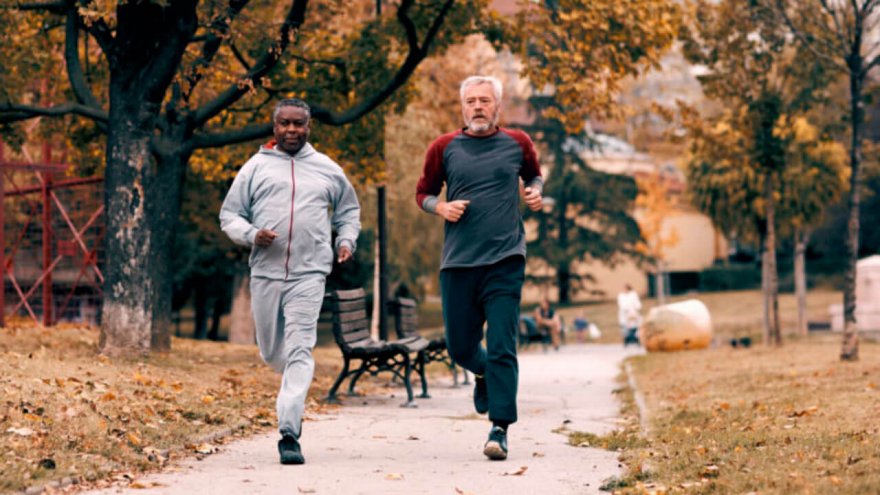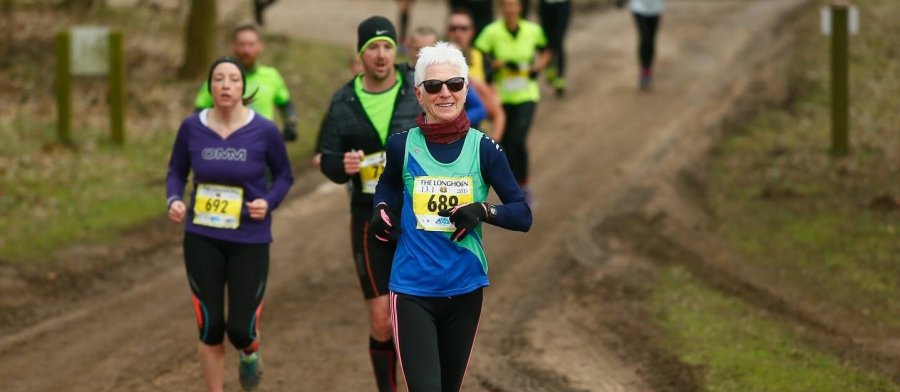How To Get Into Running After 50!

If you are staring at turning 50 right down the road, you may be contemplating making some lifestyle changes. Whether you have put on a few pounds or just started to be more sedentary than you had been, you always have an opportunity to make changes to bring yourself to a healthier you.
A lot of you asked us about running over 50, so we decided to share our thoughts on it.
Is Running Good For People Over 50?
If you have never been a runner, you might think that starting to run at 50 is scary. We get it. Anything new can be a little intimidating. However, it does not have to be. As you age, you should be cognizant of the fact that easing into things is important.
Don’t think about jumping right into a workout regiment without putting some thought into it.
Starting Over Considerations
✓ Talk to your doctor! Before jumping into a workout regiment, it is always advisable to talk to your doctor. Just make sure things are in good working order before getting started.
✓ Start slow and easy. If you are thinking of running for your new form of exercise, ask yourself if you can walk briskly for 30 minutes or more. If you cannot, start there.
✓ Flexibility and mobility matter! Don’t fall victim to the stretching of our youth. As you work to increase your mobility, consider yoga and dynamic stretching to increase your range of motion.
✓ Don’t forget strength! Sure, once upon a time we all worried about how much we could lift. It’s never too late to increase how much you can lift; however, as you age, you sure don’t have to focus on that. There are absolutely benefits of light lifting and cardio weights such as circuits.
✓ Remember you can’t out-exercise what you put on your plate! A common error people make is to start their day with a great workout and then overindulge. As you work to start a fitness routine, think about diet.
✓ Fuel is important. Within 30-60 minutes of your workout, you should get in a protein and a carbohydrate. Make sure you are taking in good calories, not junk! Especially as we age and those pounds tend to creep up.
Running Is Not Just Great Cardio
When you are engaging in a cardiovascular workout, you are improving your heart health. According to the American Heart Association, you should work to get at least 30 minutes of purposeful movement each day.

Running is also great because it is an impact exercise. Impact exercises are important, especially for women, to prevent osteoporosis. Building strong bones is always important, but even more so as we age!
Also, an exercise that tones and builds muscles, running is good for those reasons.
How To Start Running At 50
If you want to start running at 50 or even after, it does not have to be scary or painful. After you have clearance to start working out, it’s pretty easy to come up with a plan.
As stated before, start by walking. If your goal is a 5K, consider walking briskly for 30-45 minutes to start off. Once you can do this three to five times easily and feel comfortable doing so, consider adding some jogging intervals.
Sure, some people just set out to jog and go until they can’t jog anymore, but that often leaves the athlete feeling dejected and like a failure. If you tell yourself you’re going to run for 20 minutes and you can’t manage it and have to walk, it feels like a failure. However, if you decide you are going to walk one minute and then jog one minute the walking is not a failure; rather, it is your workout plan!
Some of the most helpful newbie runner plans out there use intervals to get you acclimated, such as the famous Couch to 5K program. Heck, thousands of athletes use the Galloway method indefinitely for their runs.
What is the Galloway method? It is where you run and walk in intervals at set, prescribed intervals. Everyone has their own sweet spot that works best for them.
If your goal is to run the entire distance, you should ease your way into things. For example, if you start out with a minute walking for every minute running, next time try 2:00 run by 1:00 walk. It is not advisable to increase your run intervals too quickly. Many coaches will tell you to do that set interval for the same amount of time and/or distance for 2-4 workouts before you move to a more challenging interval.
As you consider running over 50 or running after 60 years old, there are people out there who will tell you that jogging is bad for you.
Is Jogging Bad For 50-Year-Olds?
That is kind of a loaded question. I don’t think that jogging is “bad” for anyone in good health. If you have bad knees or heart problems and your physician has warned you that jogging is not something you should do, your doctor could be right. However, be warned that some people think jogging is just bad and will “wreck your knees.”
Honestly, think about how crazy that sounds. There are runners across the globe of all shapes and sizes. If running wrecked your knees there would be people in sweatsuits gimping around all over the place.
Just remember that as you age you may need to slow down a little. If the effort starts to feel harder, just ease up a little.
Can I Run A Marathon At 50?
Do you want to run a marathon? If you do the answer is yes. Big dreams equal big goals. However, big goals like this require a big-time commitment. Just something important to remember before you click “register” for a marathon.

Believe it or not, some people never toe the line for a race before registering for the 26.2. Personally, I think that most people would benefit from racing a half marathon before biting off the full, but that is really a personal preference.
How to Use Interval Training to Get Into Running
What is Interval Walking?
Simply put, interval walking is alternating between walking at a comfortable, sustainable pace and walking very fast at a pace that feels strenuous and would be hard to sustain for any more than a couple of minutes (imagine when you’re late for a train but don’t want to break into a full-blown run through the station).
Benefits of Interval Walking
While the benefits of walking are well known, there are significant benefits to interval walking too. As well as cardiovascular benefits that come from raising your heart rate more than normal walking, intervals can also be a good way to help you progress to running workouts, or just act as a way to turn your daily commute into a workout.
Interval walking will ask more of your body than walking at a steady pace, so will have a much greater impact on your fitness levels and the number of calories you burn per session. Depending on the intensity of your intervals, you could find that you’re able to burn the same number of calories in 40 minutes of intervals that you would in 1 hour at a moderate pace.
Even though intervals can even border on vigorous exercise (especially if you’re walking uphill) walking is still much lower impact than other forms of intense cardio like running.
You’ll also still benefit from the flexibility of a running workout though, as interval walking can take place anywhere – inside or out. All you need is a watch, timer or even your mobile phone to time yourself.
What is Interval Running?
Interval training is simple to do and offers runners (or even aspiring runners) a way to continuously improve. The method at its core is simple: alternate running fast for a short distance, with slowing down your pace to recover. This offers runners a way to continuously challenge themselves and in turn make continuous improvements.
What are the Benefits of Interval Running?
Interval training is going to improve your level of fitness quicker than any other form of running. By giving yourself periods of recovery in between bouts of harder effort you will become more accustomed to working at harder intensities, resulting in a greater response to your muscular endurance, power, and speed, as well as cardiorespiratory fitness.
How can Interval Running Help with Running Performance?
When it comes to shorter distance races (think 5k or 10k), most people struggle with the lactate accumulation that builds up in their muscles throughout the race. By adding intervals into your preparation, you can train your body to tolerate and process these waste products more effectively, whilst also improving your body’s efficiency at utilizing oxygen – all of which will help you last longer at faster speeds.
Improving your efficiency also translates to longer distances. The more efficiently you run at a given pace, the less energy your body requires to keep you going.
This means you can maintain good posture and good running form for longer and longer periods, helping your cardiorespiratory system to operate optimally throughout the duration of your runs.
Tips for Older Runners Who Are New to Interval Running
The one drawback of running, especially for those who are new to it, is that it is a high-impact activity making it harder on the joints of the lower extremities. Combine this with the high-intensity nature of interval training and your body may not know what is hitting it!
There is no need to worry though. If you are new to running intervals your training could include periods of jogging alternated with a brisk walk to help you catch your breath again. For more experienced runners intervals could involve alternating short sprints with longer periods of recovery.
Just remember to keep your rest periods longer than your work periods to begin with (2mins fast, 5 mins recovery for example) and separate your runs by at least 48 hours to give your body an opportunity to adapt to the increased demands you are making of it.
What are Some Ways to Incorporate it Into a Training Plan?
By slightly altering the repetitions and rest periods of an interval you can create a near infinite number of workouts, each with its own list of benefits. Whether you are looking to complete your first 5k or next ultramarathon slow and steady will finish the race… but by adding periods of higher intensity (faster pace, running uphill, utilizing a weight vest) you can challenge your body to adapt to new stimuli making race day all the more manageable.
The most helpful way to plan your intervals is to think about them in advance – generally speaking the harder the rep the easier the rest should be, but if you are not used to running at different intensities and think planning out your workout may not give you the flexibility you need to get through it, think about a fartlek run instead. Think of fartlek running (the Swedish term for speed play) like an unstructured interval session.
For an effective 30-minute introduction: After a 10-minute warm-up at a comfortable pace, pick a visual checkpoint or landmark in the distance and increase your speed to a challenging pace – less than a flat-out sprint, but quick enough that you wouldn’t be able to sustain it for more than 5 minutes.
Once you reach your checkpoint, go back to your comfortable jogging pace and plan your next landmark. Repeat and recover likes this for 10 minutes (you can always increase the duration as you become more experienced) before going back into a 10-minute cooldown.
Just Start Moving
If you have read this far you must really be serious about starting to run as you flip into the second half of your life. Guess what? You are in great company. There are many runners over 50!
Truly, the best thing you can do if you really are invested in this idea is to buy yourself some quality running shoes and just start moving. You deserve this “me time.” Your body will thank you for it!
*This article has been written with the help of Jack McNamara, CSCS, MsC, Lead Tutor at TRAINFITNESS
Latest Articles
 Is Running on a Treadmill Easier Than Running Outside?Runners have their own preferences, whether it is treadmill running, running outside on the road, or exploring trails. So...
Is Running on a Treadmill Easier Than Running Outside?Runners have their own preferences, whether it is treadmill running, running outside on the road, or exploring trails. So... Is It OK to Use Trail Running Shoes on the Road?While trail running shoes can be used on roads, especially in situations where a runner encounters mixed terrains or pref...
Is It OK to Use Trail Running Shoes on the Road?While trail running shoes can be used on roads, especially in situations where a runner encounters mixed terrains or pref... How to Fix Sore Quads After Running?Rest, ice, gentle stretching, and over-the-counter pain relievers can help soothe sore quads after running. Also, ensure ...
How to Fix Sore Quads After Running?Rest, ice, gentle stretching, and over-the-counter pain relievers can help soothe sore quads after running. Also, ensure ... 10 Fruits With The Most Electrolytes to Replace Sports DrinksThese fruits are high in electrolytes such as potassium, magnesium, and calcium, essential for hydration, muscle function...
10 Fruits With The Most Electrolytes to Replace Sports DrinksThese fruits are high in electrolytes such as potassium, magnesium, and calcium, essential for hydration, muscle function...

